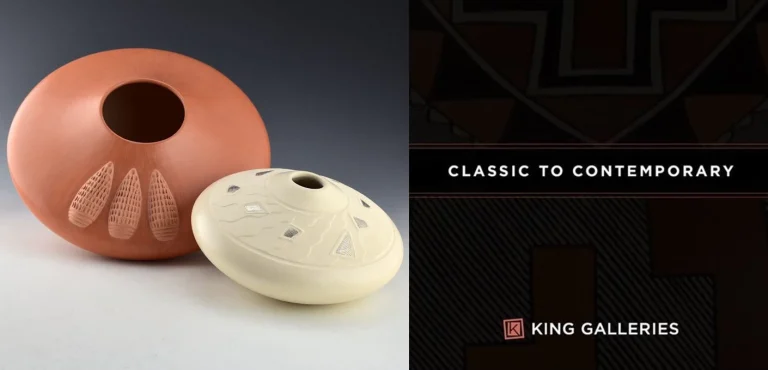Collector's Corner
A CELL PHONE CONVERSATION: Susan Folwell’s If Life Gives You Lemons and Mavasta Honyouti’s Generations
The telephone in all of its incarnations has definitely changed how humans communicate. However, its most recent manifestation, the cell phone, has transformed life in ways that could not have been foreseen: One can carry a cell phone anywhere one wishes; it can be used to take photographs, calculate, answer questions, do research and more. The cell phone has become a way of life for millions around the world. Most would never think of leaving home without it. It should come as no surprise, then, that artists have used the concept of the cellphone to express various themes that interest them.
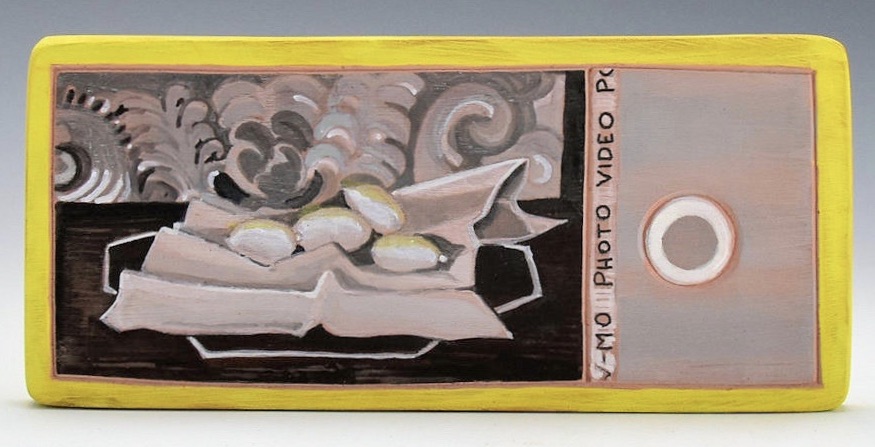
If Life Gives You Lemons (after Victor Higgins) by Susan Folwell, Santa Clara Pueblo, ceramic tile, 6.75” x 3” (2020). Collection of E. J. Guarino. Image courtesy of King Galleries. Recto

If Life Gives You Lemons (after Victor Higgins)
Verso
If Life Gives You Lemons (after Victor Higgins) is part of Susan Folwell’s Taos Light: Monochrome series. The design of this ceramic tile mimics the appearance of a cellular phone. According to Charles King, owner of King Galleries, “Beginning in 2017, Susan Folwell began a series of clay pieces inspired by and re-interpreting the Taos Society of Artists’ work from 1915-27. . . . The piece is made from clay and carved for the relief portion of the ‘button’ and edge of the frame. The piece . . . is inspired by a painting by Victor Higgins entitled, Still Life, Lemons. She captured the monochromatic feel of the lemons and wallpaper. Of course, the cell phone ‘case’ is painted yellow for the lemons!”
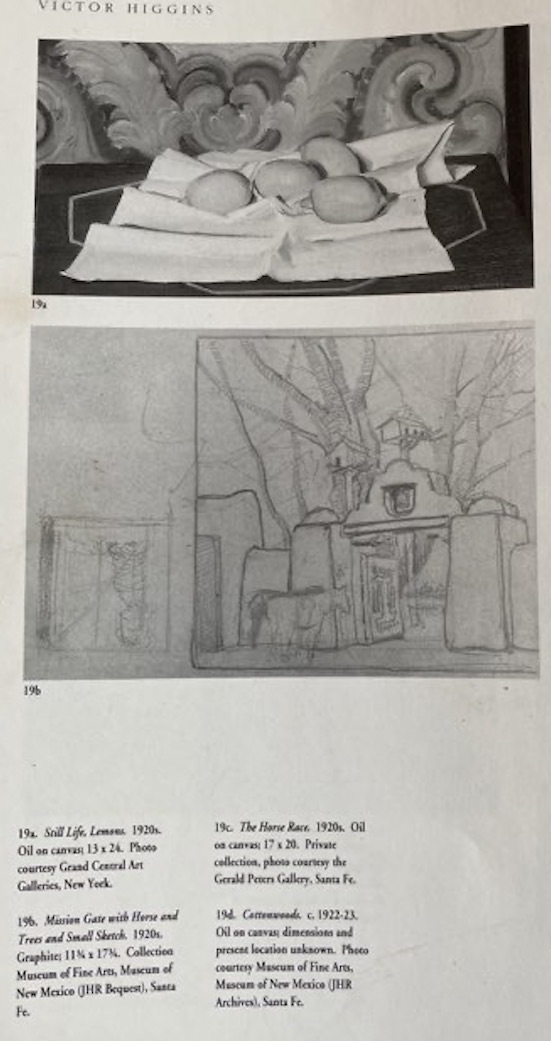
Black-and- white photograph that inspired Susan Folwell. Image courtesy of King Galleries.
Susan Folwell was working on her Taos Light: Monochrome series during the CoVid lockdown in 2020 and stated, “During this time when you can’t leave your house it is your ‘virtual vacation’. Each clay tile is carved as a ‘cell phone’ and then painted. My Taos Light: Monochrome series is inspired by black-and-white photography of early Taos painters’ work found in a book. As well, there is a photo of Jerry Mirabal, a frequent model for EI Couse [artist Eanger Irving Couse], looking at a photo of a Couse painting. That photograph set me on the course of inspiration for this series.”
For anyone who has followed the course of Susan Folwell’s artistic career, it is not surprising that she would be inspired by the work of the Taos painters, or that she would employ the shape of a cell phone as her canvas. She has always been an artistic innovator and an artist who doesn’t slavishly produce one particular style over and over. She continues to create socially and politically provocative works as well as those that are erotic and quite a number that are humorous and simply fun to view. Many of Susan Folwell’s works are highly personal, often inspired by various people and experiences in her life. Such pieces reveal a tender, sometimes romantic nature. As in If Life Gives You Lemons (after Victor Higgins), the artist doesn’t simply reference popular culture and modern technology, but uses it for her own artistic ends.
Susan Folwell’s ability to move back and forth from one style to another with apparent ease and what seems like lightening speed is astonishing. Each of her explorations of style has an artistic purpose as do the forms she chooses. Folwell’s body of work reflects a love of beauty, a keen interest in the world, a sharp intelligence, and a social conscience supported by wit, irony, elegance, humor, satire and creativity. It is why her work continues to enthrall collectors, curators and museum-goers.
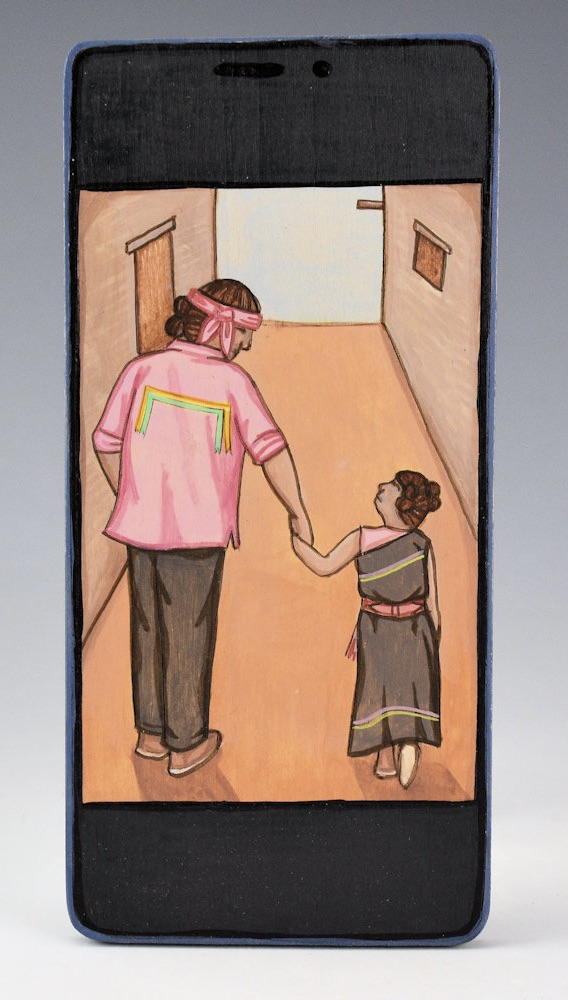 |
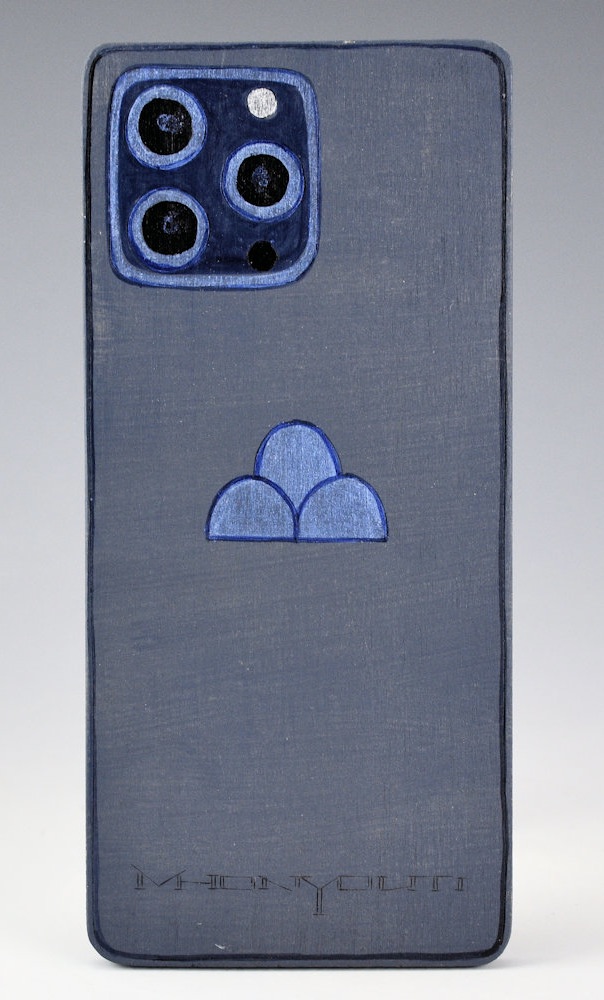 |
|
Recto |
Verso |
Generations by Mavasta Honyouti, Hopi-Tewa, cottonwood, paint, 3″x 6.5” (2025). Collection of E. J. Guarino. Images courtesy of King Galleries.
Like Susan Folwell, Mavasta Honyouti has used the idea of the cell phone as a contemporary canvas on which to project his artistic vision. Generations presents a charming familial image of a father holding his young daughter’s hand. To add to the cell phone motif, the artist has painted the back of the piece to reflect the reverse side of a typical cell phone.
Generations is both heartwarming and thought-provoking, causing the viewer to wonder where the two figures might be going as they look so tenderly at each other. The path they are on appears to be going upward towards brightness and, thus, creates a positive feeling.
Mavasta Honyouti takes inspiration from his Hopi culture, but also from mainstream popular culture. In addition to complex katsina sculptures, Mavasta Honyouti also creates scenes carved in low relief (plaques), carvings that resemble pottery, skateboard decks, and cylindrical works containing multiple figures portraying various aspects of Hopi Katsina dances. He has also produced wooden plaques and bow guards that reference Star Wars, but incorporate Hopi imagery such as classic Hopi clouds, hummingbirds, butterflies, dragonflies as well as Hopi pottery designs. Much of his work combines complex designs and bright colors. His work is an embodiment of his belief that we are surrounded by beauty.
It is always fascinating to see the evolution of artists. Some do so while remaining decidedly traditional, using long-established imagery, conventional media, and customary techniques. However, there are also some who skirt the very boundaries of the traditional without going over them; still others appear to throw caution to the wind and break all of the established rules; and there are even those who move back and forth between extremes. It is one of the things that makes art so interesting. Whether a museum-goer, curator, or collector, it is always exciting to come across something new. Indigenous artists are able push well beyond what has been done before without casting the past aside. It is a concept that has come to be known as continuum. Both Susan Fowell and Mavasta Honyouti stretch themselves as artists. While deeply routed in their culture, they are also able to embrace new concepts, materials, and forms.
